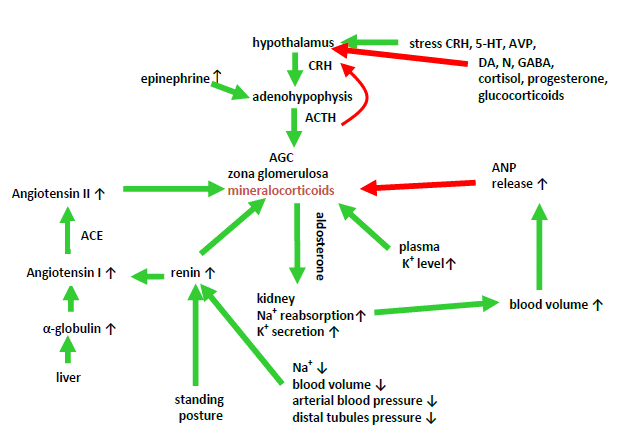III.3.D. The renin-angiotensin-aldosterone system (RAAS)
Aldosterone
This is released from the adrenal gland cortex (AGC) stratum zona glomerulosa.
Effects:
Its main effect is the regulation of the Na+-K+ metabolism in the renal collecting ducts:
tubular Na+ reabsorption is increased (this increases the serum Na+ level),
tubular K+ release is increased (this decreases the serum K+ level),
tubular H+ release is increased (this increases the serum pH).
The BP is increased, because the reabsorbed salts are followed osmotically by water (hypervolemia).
It maintains renal glomerulus filtration.
It regulates the carbohydrate and fat metabolisms.
Renin
This is released from the granular cells in the renal afferent arteriole wall.
It is stimulated by a decrease of the ECF volume, a decrease of the BP in the kidneys and in the periphery, an SNS effect (B1 adrenergic effect), a decrease of pressure in the distal tubules or the Cl- and Na+ levels, prostacyclins, and a decrease in Ca2+ level in the renal cells.
It is inhibited by: A-II and Arg vasopressin (AVP or ADH – antidiuretic hormone).
Angiotensin-II
Angiotensinogen is converted to A-I by renin released from the kidney, and A-I is then converted to the active A-II by ACE released from the lung (Fig. 7). A-II enhances the BP and the release of aldosterone. A-II enhances peripheral and central adrenergic effects. It activates thrombocyte aggregation. It stimulates contraction and thickening (hypertrophy) of the smooth muscle and the myocardium.
Aldosterone and A-II increase oxidative stress, inflammation and coagulation. In the event of insulin resistance, these effects are enhanced.

Figure 7. Regulation of renin-angiotensin-aldosterone release
(red arrow = inhibition, green arrow = stimulation)